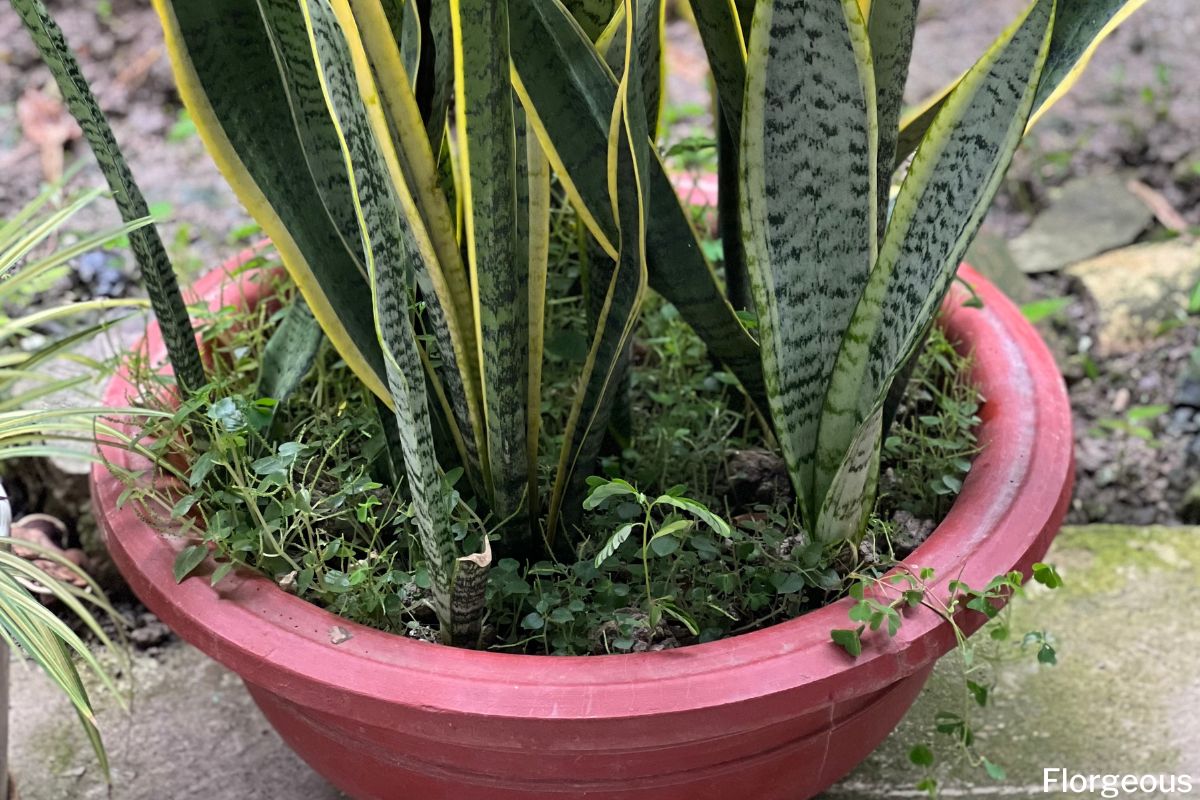Snake plants are the superheroes of the houseplant world, known for their resilience and striking looks. But even these tough cookies need the right support to truly thrive. That’s where potting soil comes in!
Ditch the all-purpose potting mix—snake plants crave well-draining soil, and standard mixes just won’t cut it! In their natural habitat, these beauties are used to arid, rocky terrain where water drains quickly. To keep your snake plant happy and healthy, you need to mimic these conditions.
This guide will walk you through everything you need to know about choosing (or creating!) the ideal potting mix to unlock your snake plant’s full potential.
Why Drainage is King (and How to Get It Right)
Imagine trying to breathe underwater – that’s what soggy soil feels like to a snake plant. These plants are highly susceptible to root rot, a fungal disease that thrives in damp conditions. When roots sit in waterlogged soil, they can’t get the oxygen they need, leading to decay and eventually, a very sad plant.
The key to preventing root rot is excellent drainage. You want a soil mix that allows water to flow through freely, leaving the roots moist but never soggy.
Here’s how to achieve snake plant-worthy drainage:
-
Choose the Right Base: Opt for a high-quality, peat-free potting mix specifically designed for succulents or cacti. These mixes are formulated to be light, airy, and free-draining.
-
Add Aeration Boosters: Think of these as the secret ingredients that make your soil extra fluffy and breathable. Some popular choices include:
- Perlite: These lightweight, white pebbles are actually volcanic rock that’s been superheated and expanded. Perlite is a drainage superstar, creating air pockets in the soil and preventing compaction.
- Pumice: Similar to perlite, pumice is another volcanic rock that enhances drainage. It’s a bit heavier than perlite, which can be helpful for taller snake plants that might topple over in super-light mixes.
- Coarse Sand: A bit of coarse sand can add weight to the pot and improve drainage. However, avoid using fine sand, as it can actually compact the soil and make drainage worse.
DIY or Pre-Mixed: Choosing the Right Path
When it comes to snake plant soil, you have two main options: channel your inner plant parent and whip up a custom blend, or keep it simple with a pre-mixed option.
DIY Snake Plant Soil Recipes
DIY is a great choice if you enjoy a bit of hands-on plant care and want to customize your soil mix perfectly. Here are two easy recipes to get you started:
Recipe #1: Simple & Effective
- 1 part Succulent/Cactus Potting Mix
- 1 part Perlite or Pumice
Recipe #2: Nutrient-Rich Blend
- 1 part Succulent/Cactus Potting Mix
- 1 part Perlite
- 1/2 part Compost or Worm Castings (use these amendments sparingly to avoid over-fertilizing)
Mixing Tips:
- Use a large bucket or tub to combine your ingredients.
- Wear gloves to protect your hands, especially when handling perlite or pumice, as they can be drying.
- Moisten the soil mix slightly after combining – you want it to be just damp, not soaking wet.
Choosing Pre-Mixed Soil: Decoding the Labels
If DIY isn’t your thing, don’t worry! There are plenty of excellent pre-mixed soils designed specifically for snake plants and their succulent cousins. Here’s what to look for (and what to avoid) on the label:
Do Choose:
- “Succulent & Cactus” or “Snake Plant” specific blends.
- Ingredients list that includes perlite, pumice, or other drainage enhancers.
Don’t Choose:
- “Moisture-control” or “Water-retaining” mixes – these can lead to soggy soil and unhappy roots.
- Soils with added fertilizers that can burn sensitive snake plant roots – it’s best to add fertilizer separately and sparingly.
Beyond Drainage: Other Factors to Consider
While drainage is paramount, other factors can also influence your snake plant’s soil happiness:
- pH Balance: Snake plants prefer slightly acidic to neutral soil, with a pH range of 5.5 to 7.0. Most quality potting mixes will fall within this range, so you probably won’t need to adjust it.
- Loamy Texture: Loamy soil is the holy grail for many plants, including snake plants. It refers to a soil texture that holds some moisture but also drains well. You can achieve a loamy texture by combining the right proportions of potting mix and aeration boosters.
Repotting: The Gift of Fresh Starts
Even the best potting soil will eventually break down and lose its drainage capabilities. That’s why it’s essential to repot your snake plant every 1-2 years. Repotting gives the roots room to grow and allows you to refresh the soil, preventing compaction and ensuring optimal drainage.
People’s Statements: What the Experts Say
“A snake plant prefers a light loamy soil that not only drains well but also registers between 5.5 to 7.0 on the pH scale. Instead of scooping up dirt from an outdoor garden bed or yard, which can become compacted or contain insects or bacteria, choose a sterile commercial potting soil that’s free of pests and disease.” (Source: Unknown)
“In short, the best potting soil for snake plants should be light, loamy soil with good drainage with added elements such as coir or perlite and sand to create air pockets and help with drainage.” (Source: growyouryard.com)
“The best type of soil for snake plants is a light, loamy, and well-draining mixture. I don’t recommend using a general-purpose potting mix on its own because many commercial brands retain too much moisture.” (Source: getbusygardening.com)
Conclusion: Setting Your Snake Plant Up for Success
Choosing the right potting soil is one of the most important things you can do to help your snake plant thrive. By focusing on drainage, understanding the role of key ingredients, and repotting regularly, you can provide the ideal foundation for your plant to flourish. Give your snake plant the best-potting mix to thrive and boost your indoor greenery with our exquisite plant decorations.
- Find the Perfect Santa Mugs: Year-Round Guide - July 6, 2025
- Find the Perfect Collectible Santa Figurines: A Guide - July 6, 2025
- Find the Perfect Santa Claus Toys: Holiday Gift Guide - July 6, 2025










